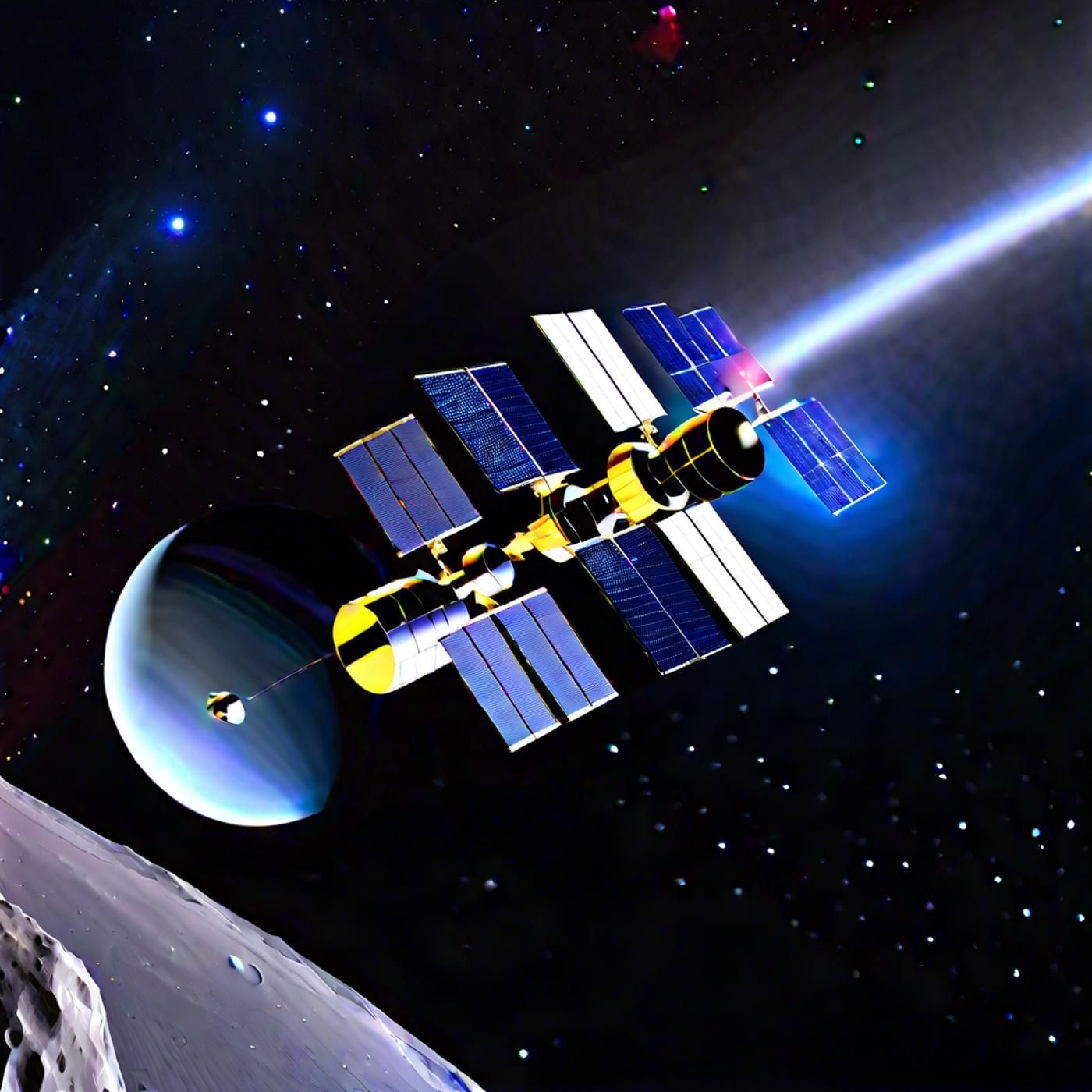S03E75: Voyager 1's Revival & ISS Spacewalk Setback

Embark on a celestial journey with today's episode of Astronomy Daily - The Podcast, where your host, Anna, brings you the latest cosmic updates. We'll delve into Voyager One's latest achievements as it resumes its science operations after a technical...
Embark on a celestial journey with today's episode of Astronomy Daily - The Podcast, where your host, Anna, brings you the latest cosmic updates. We'll delve into Voyager One's latest achievements as it resumes its science operations after a technical glitch. We'll also discuss the recent spacewalk cancellation on the International Space Station due to a spacesuit discomfort issue. And don't miss out on the new findings from NASA's Perseverance rover on Mars, which has just reached a new area of scientific interest. Stay tuned for these stories and much more.NASA's Voyager One has fully resumed its science operations after resolving a technical issue that had been affecting its capabilities since November 2023. This remarkable spacecraft, now over 15 billion miles from Earth, is once again collecting crucial data from its four science instruments, providing invaluable insights into the nature of interstellar space. After a series of careful diagnostics and repairs, the mission team successfully restored the instruments to their full operational modes. Engineers will continue to perform minor maintenance tasks, including resynchronizing the timekeeping software and maintaining the digital tape recorder that stores data for the plasma wave instrument. As Voyager One continues its journey, it remains one of NASA's most historic missions, shedding light on the mysteries of space far beyond our solar system.A spacesuit discomfort issue forced NASA to cancel a planned spacewalk on the International Space Station today. The spacewalk, set to be a routine six-hour mission involving astronauts Tracy C. Dyson and Matt Dominick, was aimed at conducting necessary repairs and science experiments. However, as the astronauts were preparing for their trek outside the station, NASA astronaut Mike Barrett requested a private line to talk to flight controllers about an unspecified medical issue, leading to the mission's cancellation. Despite the setback, NASA assured the public that there was no emergency, and the mission will be rescheduled.After an arduous journey, NASA's Perseverance rover has reached a new area of scientific interest on Mars, dubbed Bright Angel. The rover navigated through a challenging dune field to avoid boulder-filled terrain, leading it to an ancient river channel full of potential geological treasures. Bright Angel, located at the base of Jezero Crater's northern channel wall, is now being studied for evidence of carbonate and olivine deposits, which could reveal secrets about the ancient river that once flowed into the crater. One particularly intriguing find is Atoko Point, a unique boulder whose composition and origin are currently under investigation.New research suggests that some planets orbiting white dwarfs may retain their water and potentially support life. White dwarfs, with their small size and dim light, provide an excellent backdrop for studying these planets. The study offers a roadmap for finding these elusive worlds and could guide future telescope missions as they search the cosmos for signs of life. The potential for discovering habitable exoplanets around white dwarfs opens up exciting possibilities for understanding planetary systems and life beyond our own solar system.Blue Origin, SpaceX, and United Launch Alliance have secured a monumental $5.6 billion in contracts from the Pentagon for the National Security Space Launch phase three program. This is a significant milestone, especially for Blue Origin, as it's their first time entering the national security launch arena. These contracts, which span over the next five years, will see the companies compete for various crucial launch missions, enhancing competition, driving down costs, and ensuring reliable access to space.In a stunning revelation, the James Webb Space Telescope has discovered that a star long believed to be a single entity, known as WL 20s, is actually a pair of twin stars. Using its mid-infrared instrument, Webb has also detected jets of gas streaming from the north and south poles of these twin stars, adding a new layer of understanding to the processes of stellar formation and evolution. Further observations have shown that each star is encircled by disks of dust and gas, suggesting that planets may be forming within these disks.
For an astronomical experience, visit our website at astronomydaily.io for the latest news, sign up for our free newsletter, and check out exclusive sponsor deals.
Connect with us on YouTube, TikTok, X, and Facebook via @AstroDailyPod for engaging discussions with fellow space aficionados. This is Anna, reminding you to keep your gaze fixed on the heavens.
Until our next stellar episode, let the cosmos ignite your curiosity and wonder. Clear skies and cosmic discoveries to all!
Support:
This podcast is better with your support:
https://www.bitesz.com/show/astronomy-daily-the-podcast/support/
www.bitesz.com
Sponsors:
www.bitesz.com/nordpass
https://www.bitesz.com/show/astronomy-daily-the-podcast/sponsors/
Transcript
Welcome to Astronomy Daily, your go-to podcast for all the latest news in space and astronomy. I'm your host, Anna. Today we have an array of exciting stories to explore. We'll delve into Voyager 1's latest achievements as it resumes its science operations after a technical glitch. We'll also discuss the recent spacewalk cancellation on the International Space Station due to a spacesuit discomfort issue. And don't miss out on the new findings from NASA's Perseverance rover on Mars, which has just reached a new area of scientific interest. Stay tuned for these stories and much more!
NASA's Voyager 1 has fully resumed its science operations after resolving a technical issue that had been affecting its capabilities since November 2023. This remarkable spacecraft, which is now over 15 billion miles from Earth, is once again collecting crucial data from its four science instruments. These instruments provide invaluable insights into the nature of interstellar space. After a series of careful diagnostics and repairs, the mission team successfully restored the instruments to their full operational modes. The data being gathered includes measurements of plasma waves, magnetic fields, and particles in the interstellar medium, offering a glimpse into a region of space that no other spacecraft have directly sampled. Though the probe is now functioning normally, engineers will continue to perform minor maintenance tasks, including resynchronizing the timekeeping software and maintaining the digital tape recorder that stores data for the plasma wave instrument.
As Voyager 1 continues its journey, it remains one of NASA's most historic missions, shedding light on the mysteries of space far beyond our solar system.
A spacesuit discomfort issue forced NASA to cancel a planned spacewalk on the International Space Station today. The spacewalk was set to be a routine six-hour mission involving astronauts Tracy C. Dyson and Matt Dominick, aimed at conducting necessary repairs and science experiments. However, as the astronauts were preparing for their trek outside the station, NASA astronaut Mike Barratt requested a private line to talk to flight controllers about an unspecified medical issue. Moments later, NASA announced via live stream that the mission would not proceed as planned for that day. This spacewalk would have been the 90th in the ISS's 23-year history, and just the second one scheduled for this year. It was supposed to be Dyson's fourth spacewalk and Dominick's first. While it's uncertain exactly what caused the discomfort or whether an unrelated medical issue played a part, it's clear that spacesuit problems are not new.
NASA has long known that the ISS's spacesuits, developed nearly fifty years ago and updated only slightly since, are in need of significant upgrades. Until those improvements are made, astronauts will continue to face challenges like this one. Despite the setback, NASA assured the public that there was no emergency and the mission will be rescheduled.
After an arduous journey, NASA's Perseverance rover has reached a new area of scientific interest on Mars, dubbed "Bright Angel." The rover had to navigate through a challenging dune field to avoid boulder-filled terrain, a detour that ultimately led it to an ancient river channel full of potential geological treasures. Originally considered just a boulder-free route, Neretva Vallis has exceeded scientists’ expectations by offering a wealth of new geological features to analyze. Bright Angel, located at the base of Jezero Crater's northern channel wall, is now being studied for evidence of carbonate and olivine deposits. These deposits could reveal secrets about the ancient river that once flowed into the crater, providing a more nuanced understanding of Mars' geological history. One particularly intriguing find is Atoko Point, a unique boulder whose composition and origin are currently under investigation. With features never before observed on Mars, this discovery could be pivotal in understanding the planet's past environmental conditions.
Perseverance continues to be a key player in NASA's mission to search for signs of ancient microbial life and to prepare for future human exploration. The rover's data collection efforts are also laying the groundwork for future missions that will transport Martian samples back to Earth for detailed analysis. The scientific community eagerly awaits the new insights this resilient rover will unveil as it continues its groundbreaking journey.
New research suggests that some planets orbiting white dwarfs, the remnants of stars that have exhausted their fuel, may retain their water and potentially support life. White dwarfs, with their small size and dim light, provide an excellent backdrop for studying these planets. The trick is spotting the shadow of a planet against the faint light of a white dwarf and finding one that has maintained its water oceans through the star's explosive final phases. Astronomers have theorized that some watery planets can indeed thread the celestial needle to survive these harrowing conditions. While it's perilous, it's possible for a planet to retain its water by being just far enough from the former star during its violent outbursts but still close enough to the shrunken white dwarf to keep liquid water in the long term. This new study offers a roadmap for finding these elusive worlds and could guide future telescope missions as they search the cosmos for signs of life. The potential for discovering habitable exoplanets around white dwarfs opens up exciting possibilities for understanding planetary systems and life beyond our own solar system.
Blue Origin, SpaceX, and United Launch Alliance have secured a monumental 5 point 6 billion dollars in contracts from the Pentagon for the National Security Space Launch Phase 3 program. This is a significant milestone, especially for Blue Origin, as it's their first time entering the national security launch arena. These contracts, which span over the next five years, will see the companies compete for various crucial launch missions. The selections are divided into two categories: Lane 1 for less demanding launches and Lane 2 for heavy lift missions capable of reaching high-performance orbits. Blue Origin's New Glenn rocket, after nearly a decade of development, is gearing up for its first orbital flight and will play a key role in these missions. SpaceX and ULA, both veterans in this field, have been pivotal in securing the U.S. Space Force's payloads over past phases and will continue to do so under Phase 3.
The Space Force aims to enhance competition, drive down costs, and ensure reliable access to space. As new technologies mature, opportunities will increase, broadening the diversity of providers ready to take on these challenging and essential missions.
In a stunning revelation, the James Webb Space Telescope has discovered that a star long believed to be a single entity, known as WL 20S, is actually a pair of twin stars. For decades, this region has been scrutinized by multiple telescopes, but it took Webb's unparalleled resolution to unveil this cosmic surprise. Using its Mid-Infrared Instrument, Webb has also detected jets of gas streaming from the north and south poles of these twin stars. These findings add a new layer of understanding to the processes of stellar formation and evolution. The discovery was presented at the 244th meeting of the American Astronomical Society, highlighting the transformative power of Webb in enhancing our knowledge of the universe. In addition to confirming the twin nature of WL 20S, further observations with the Atacama Large Millimeter/submillimeter Array have shown that each star is encircled by disks of dust and gas. Such insights suggest that planets may be forming within these disks, providing a rare opportunity to study the early stages of planetary formation.
This twin star discovery underscores the significance of the James Webb Space Telescope in broadening our perspective on the cosmos and unlocking secrets that previous telescopes could not reveal.
Thank you for tuning in to today's episode of Astronomy Daily. I'm Anna, your host, and I'll be back tomorrow with more exciting space news. Don't forget to visit our website at astronomydaily.io for more stories, past episodes, and to sign up for our free daily newsletter. Until tomorrow, bye bye and remember to keep looking up. You never know what you might see.
New to Astronomy Daily - The Podcast?
Here are some great episodes to start with.




















